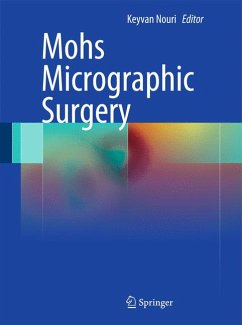Mohs Micrographic Surgery (eBook, PDF)
Redaktion: Nouri, Keyvan


Alle Infos zum eBook verschenken

Mohs Micrographic Surgery (eBook, PDF)
Redaktion: Nouri, Keyvan
- Format: PDF
- Merkliste
- Auf die Merkliste
- Bewerten Bewerten
- Teilen
- Produkt teilen
- Produkterinnerung
- Produkterinnerung

Hier können Sie sich einloggen

Bitte loggen Sie sich zunächst in Ihr Kundenkonto ein oder registrieren Sie sich bei bücher.de, um das eBook-Abo tolino select nutzen zu können.
The incidence of skin cancer is 3.5 million per year and accounts for more than fifty percent of all cancers combined, the majority of which are basal cell and squamous cell carcinomas. Mohs surgery has become the treatment of choice for certain basal cell and squamous cell carcinomas and other cutaneous tumors, with a high cure rate and low recurrence rate. Physicians in all of the major disciplines of medicine will encounter patients with cutaneous cancers whom have undergone Mohs surgery or may need it in the future.
Mohs Micrographic Surgery has been written to serve as a tool to build…mehr
- Geräte: PC
- ohne Kopierschutz
- eBook Hilfe
- Größe: 34.78MB
![Mohs Micrographic Surgery: From Layers to Reconstruction (eBook, PDF) Mohs Micrographic Surgery: From Layers to Reconstruction (eBook, PDF)]() Christopher B. HarmonMohs Micrographic Surgery: From Layers to Reconstruction (eBook, PDF)146,95 €
Christopher B. HarmonMohs Micrographic Surgery: From Layers to Reconstruction (eBook, PDF)146,95 €- -20%11
![Halslymphknotenentfernung - Neck-Dissection (eBook, PDF) Halslymphknotenentfernung - Neck-Dissection (eBook, PDF)]() Boban M. ErovicHalslymphknotenentfernung - Neck-Dissection (eBook, PDF)79,99 €
Boban M. ErovicHalslymphknotenentfernung - Neck-Dissection (eBook, PDF)79,99 € - -20%11
![Radiofrequenztherapie in der Kopf-Hals-Chirurgie (eBook, PDF) Radiofrequenztherapie in der Kopf-Hals-Chirurgie (eBook, PDF)]() Claudia LillRadiofrequenztherapie in der Kopf-Hals-Chirurgie (eBook, PDF)39,99 €
Claudia LillRadiofrequenztherapie in der Kopf-Hals-Chirurgie (eBook, PDF)39,99 € ![Atlas of Lacrimal Drainage Disorders (eBook, PDF) Atlas of Lacrimal Drainage Disorders (eBook, PDF)]() Mohammad Javed AliAtlas of Lacrimal Drainage Disorders (eBook, PDF)225,95 €
Mohammad Javed AliAtlas of Lacrimal Drainage Disorders (eBook, PDF)225,95 €![Atlas of Surgical Approaches to Paranasal Sinuses and the Skull Base (eBook, PDF) Atlas of Surgical Approaches to Paranasal Sinuses and the Skull Base (eBook, PDF)]() Dan M. FlissAtlas of Surgical Approaches to Paranasal Sinuses and the Skull Base (eBook, PDF)121,95 €
Dan M. FlissAtlas of Surgical Approaches to Paranasal Sinuses and the Skull Base (eBook, PDF)121,95 €![Manual of Oculoplastic Surgery (eBook, PDF) Manual of Oculoplastic Surgery (eBook, PDF)]() Manual of Oculoplastic Surgery (eBook, PDF)105,95 €
Manual of Oculoplastic Surgery (eBook, PDF)105,95 €![Fat Injection (eBook, PDF) Fat Injection (eBook, PDF)]() Fat Injection (eBook, PDF)255,95 €
Fat Injection (eBook, PDF)255,95 €-
-
-
Mohs Micrographic Surgery has been written to serve as a tool to build a foundation of the fundamentals of Mohs surgery. Each chapter is easy to read, with summary boxes of all the major points. The chapters are written by world-renowned physicians in their respective specialties. Overall, the reader will enjoy an up-to-date, reliable source of information on all important aspects of Mohs surgery, and will obtain a detailed understanding of this surgery, which will greatly benefit patient care.
Dieser Download kann aus rechtlichen Gründen nur mit Rechnungsadresse in A, B, BG, CY, CZ, D, DK, EW, E, FIN, F, GR, HR, H, IRL, I, LT, L, LR, M, NL, PL, P, R, S, SLO, SK ausgeliefert werden.
- Produktdetails
- Verlag: Springer London
- Seitenzahl: 563
- Erscheinungstermin: 15. Februar 2012
- Englisch
- ISBN-13: 9781447121527
- Artikelnr.: 37359990
- Verlag: Springer London
- Seitenzahl: 563
- Erscheinungstermin: 15. Februar 2012
- Englisch
- ISBN-13: 9781447121527
- Artikelnr.: 37359990
- Herstellerkennzeichnung Die Herstellerinformationen sind derzeit nicht verfügbar.







